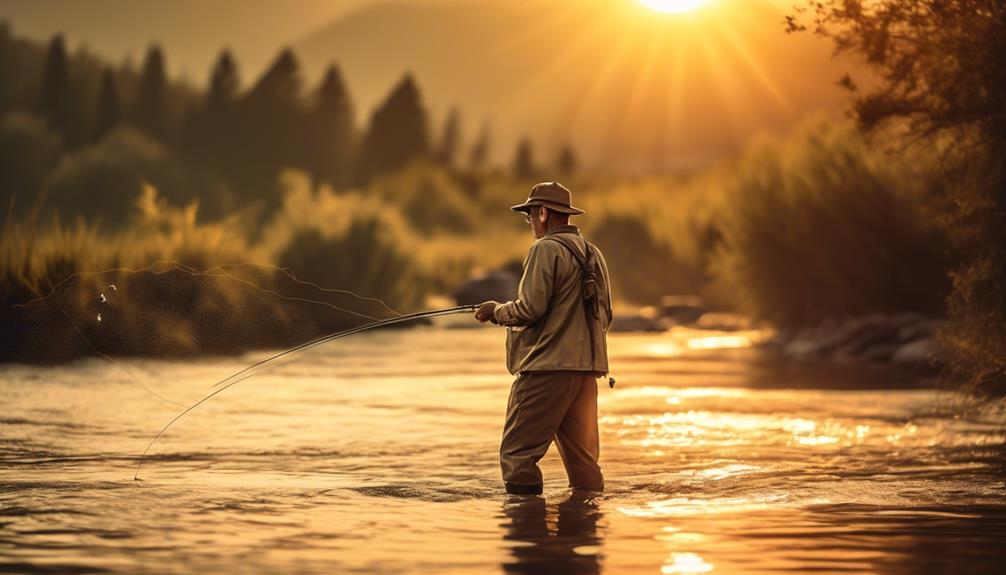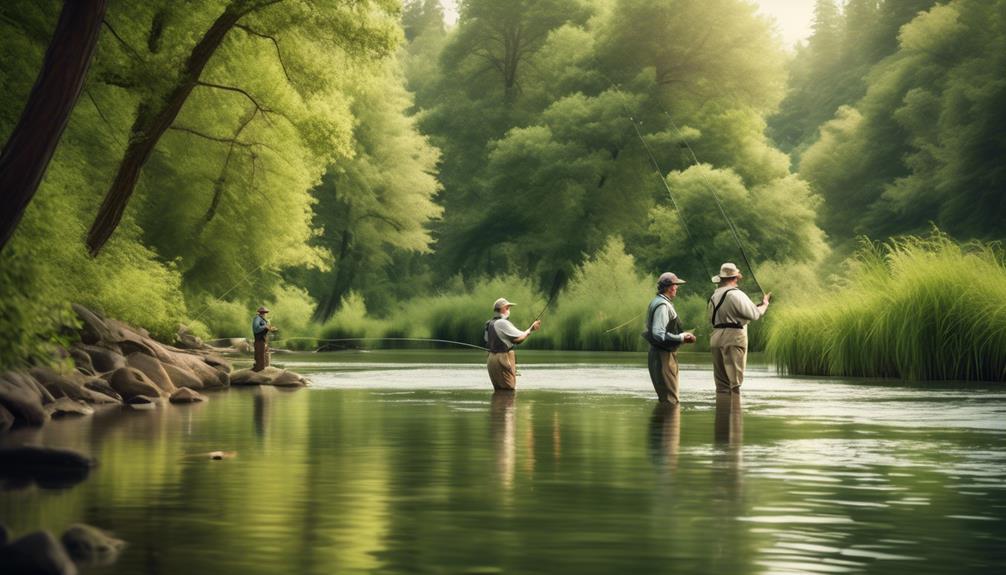Ever wondered why some fly fishermen seem to effortlessly cast their lines while others struggle to get their fly to land just right? The key might lie in mastering the essential tips for effective fly fishing casting.
With the right techniques, you can improve your accuracy, distance, and presentation, making each cast count. Whether you're a beginner looking to hone your skills or a seasoned angler aiming to refine your casting, these eight essential tips can make a significant difference in your fly fishing experience.
Proper Grip and Hand Position
To achieve a more accurate and effortless cast, ensure your grip on the fly rod is firm yet relaxed. Your hand should be positioned on the rod grip with a gentle, non-restrictive hold. This allows for better control and flexibility during the casting motion.
Maintaining correct posture is crucial; stand with your feet shoulder-width apart, knees slightly bent, and your body facing the direction you intend to cast. This will provide a stable base for your casting movements, allowing for improved accuracy and distance.
When it comes to finger placement, your index finger should be extended along the top of the rod, pointing toward the fly. Your remaining fingers should curl comfortably around the rod, providing support and stability. Avoid gripping the rod too tightly, as this can lead to muscle fatigue and reduced sensitivity in detecting strikes. Conversely, an overly loose grip may result in loss of control and accuracy in your casting.
Additionally, be mindful of your wrist and forearm movements. Your wrist should remain relatively firm during the casting process, with the power generated from the forearm. This technique allows for a smoother, more controlled casting motion, enabling you to direct the fly precisely to your desired target.
Understanding Rod Loading
Understanding rod loading is essential for achieving efficient and effective fly fishing casts. When you understand how the rod flexes and loads during a cast, you can harness that energy to propel your fly line accurately and with minimal effort. Here are five key points to help you grasp the concept of rod loading and improve your casting mechanics:
- Rod Flex: Understanding how your fly rod flexes during the casting motion is crucial. As you accelerate the rod during the casting stroke, it bends or flexes, storing energy that will be released to propel the line forward.
- Timing is Everything: Proper timing in casting is vital for optimal rod loading. You need to coordinate the acceleration of the rod with the unrolling of the line to achieve maximum casting efficiency.
- Power Application: Applying power smoothly and progressively during the casting stroke ensures that the rod flexes uniformly, leading to efficient energy transfer and better line control.
- Feel the Rod: Developing a sense of how the rod loads and unloads during the casting process is essential. Learning to feel the rod's movements will help you apply the right amount of power and achieve better casting results.
- Practice and Observation: By practicing regularly and observing how the rod behaves during different casting scenarios, you can improve your understanding of rod loading and refine your casting mechanics.
Understanding rod loading and how to utilize it effectively will significantly enhance your fly fishing experience, allowing you to cast with precision and control while expending minimal effort.
Mastering the Timing and Tempo
Mastering the timing and tempo of your casting stroke is crucial for achieving efficient rod loading and maximizing your casting distance and accuracy. When it comes to fly fishing, the timing and tempo of your casting stroke play a significant role in determining the accuracy and distance of your cast. By mastering the timing and tempo, you can ensure that your fly lands precisely where you intend it to, improving your chances of a successful catch.
To enhance your casting accuracy, focus on the timing of your forward and backcasts. Timing your casts properly allows the line to straighten out fully, which is essential for achieving accuracy. It's important to maintain a steady tempo throughout your casting stroke to ensure that the line is managed effectively. A consistent tempo helps in controlling the energy transfer from the rod to the line, resulting in smoother and more accurate casts.
Additionally, mastering the timing and tempo of your casting stroke is crucial for proper line management. A well-timed and rhythmic casting stroke aids in managing the amount of line that's aerialized during the cast, which is essential for achieving greater casting distance and accuracy.
Utilizing the Power of Wrist Snap
Enhance your casting technique by incorporating a powerful wrist snap into your casting stroke for increased line speed and distance. The wrist snap is a crucial component of a successful fly fishing cast, as it allows you to propel the line with greater force and accuracy. By mastering the technique of wrist snap, you can significantly improve your casting performance and achieve greater distances with improved accuracy.
- Proper Wrist Position: Ensure that your wrist is in a neutral position before initiating the snap. This will allow for maximum power and control during the casting stroke.
- Engage Your Forearm: Utilize the strength of your forearm in conjunction with the wrist snap to generate additional power and speed in your cast.
- Timing is Key: Focus on the timing of your wrist snap in relation to the casting stroke. The snap should occur at the precise moment when the rod tip is accelerating forward.
- Smooth Transition: Practice achieving a smooth transition from the wrist snap to the stop position, as this fluid motion will result in a more efficient and powerful cast.
- Consistent Practice: Regularly practice the wrist snap technique to develop muscle memory and improve your overall casting proficiency.
Managing Line Control and Slack
To improve your fly fishing casting technique, focus on maintaining precise line control and minimizing slack to effectively present your fly to the target. Managing line tension is crucial in fly fishing casting.
One way to achieve this is by keeping your rod tip low during the cast and then raising it gradually as the line extends. By doing so, you can prevent excessive slack from forming in the line, which could lead to tangles or missed strikes. Maintaining tension also allows for better control over the fly's presentation, making it appear more natural to the fish.
Avoiding line snags is another essential aspect of managing line control and slack. Make sure to keep an eye on the line's trajectory during the cast, and be mindful of any potential obstructions that could cause the line to snag. Being aware of your surroundings and adjusting your casting angle can help minimize the risk of the line getting caught on objects such as branches or rocks.
Additionally, practicing smooth, controlled casting motions can reduce the likelihood of creating excess slack or causing the line to snag on itself.
Practicing the Double Haul Technique
To build on your line control and tension management skills, incorporating the double haul technique into your casting can significantly improve your casting distance and accuracy. The double haul technique involves using both your casting hand and line hand to create additional line speed and tension, allowing you to cast with more power and control.
Here are some essential tips to help you practice and master the double haul technique:
- Focus on Timing: The key to a successful double haul is the coordination between your casting stroke and the pulling motion of your line hand. Practice the timing to ensure that both hands are working in sync to generate maximum line speed.
- Start Slow: When learning the double haul, it's important to start with slow, deliberate movements to understand the mechanics and timing. As you become more comfortable, gradually increase your speed and power.
- Utilize Your Body: Engage your core and use your body's rotation to add power to your casting stroke. The double haul isn't just about your arms; it's a full-body technique that can help you increase casting distance.
- Keep the Rod Tip Tracking: Focus on keeping the rod tip tracking in a straight line during both the casting stroke and the line haul. This will optimize the energy transfer and help improve accuracy.
- Practice, Practice, Practice: Like any new skill, mastering the double haul technique requires consistent practice. Dedicate time to regular practice sessions to refine your technique and see improvements in both accuracy and casting distance.
Incorporating the double haul technique into your fly fishing casting can be a game-changer, allowing you to improve accuracy and increase distance in your casts. With focused practice and attention to technique, you can elevate your casting skills and enjoy more successful fishing experiences.
Adjusting for Wind and Obstacles

When dealing with wind and obstacles while fly fishing, it's crucial to adapt your casting technique to maintain accuracy and control.
Wind adjustment is a key consideration when casting in outdoor environments. To compensate for wind, you should angle your cast slightly into the wind. This will help the line and fly to travel in the intended direction despite the wind's influence. Additionally, slowing down your casting stroke can help reduce the impact of the wind on your line. By making these adjustments, you can maintain precision and achieve your desired casting distance even in windy conditions.
Obstacle avoidance is another important aspect of adjusting your casting technique. When faced with obstacles such as overhanging branches or rocks in the water, it's essential to modify your casting stroke to avoid getting tangled or caught. One effective strategy is to utilize a sidearm or underhand cast to navigate under low-hanging obstructions. This technique allows you to deliver the fly to the target area without getting obstructed by overhanging branches.
Incorporating these adjustments into your casting technique will enhance your ability to effectively fish in challenging conditions. By adapting to wind and obstacles, you can maintain accuracy, control, and ultimately increase your chances of a successful fly fishing experience.
Fine-Tuning Your Presentation Skills
Improving your presentation skills in fly fishing involves refining your technique to effectively entice the fish with your fly. Fine-tuning your presentation skills can significantly enhance your success on the water. Here are some essential tips to help you improve your presentation skills:
- Perfect Your Presentation Posture: Your body position plays a crucial role in your presentation. Ensure that your shoulders are relaxed, and your casting arm is extended comfortably. This posture allows for smoother and more accurate casting, ultimately improving your presentation to the fish.
- Focus on Casting Accuracy: Pay attention to the accuracy of your casts. Practice hitting specific targets in the water to simulate real fishing scenarios. Improving your accuracy will make your presentation more enticing to the fish, increasing your chances of a successful catch.
- Master the Art of Mending: Mending is the technique of repositioning the fly line on the water to create a natural drift. By mastering mending, you can present the fly in a more natural and appealing manner, making it more likely for the fish to strike.
- Utilize Proper Fly Selection: The choice of fly is integral to your presentation. Understanding the insects and baitfish in the area will help you select the most enticing fly for the fish, enhancing your presentation.
- Observe and Adapt: Pay close attention to how the fish are reacting to your presentation. If you notice a lack of interest, be ready to adapt your presentation by changing your fly pattern or adjusting your casting approach.
Frequently Asked Questions
How Do I Choose the Right Fly Fishing Rod for My Casting Style and Skill Level?
When choosing the right fly rod for your casting style and skill level, consider the different casting techniques you use. Explore the fly rod options available and find one that suits your needs.
What Are Some Common Mistakes That Beginners Make When Learning to Fly Fish?
When learning to fly fish, common mistakes include improper casting techniques and not reading the water. Correcting errors involves practicing basic casts and understanding the importance of fly presentation. Improving skills requires patience and dedication.
Are There Any Specific Exercises or Drills I Can Do to Improve My Casting Technique?
To improve your casting technique, try specific exercises and drills. Practice casting drills like the roll cast and the double haul. These casting techniques can enhance your skills and make your fly fishing experience more successful.
How Do I Know When to Switch to a Different Fly or Lure for Better Casting Results?
When to switch to a different fly or lure for better casting results? Consider different fly and lure options to improve casting technique. Experiment with various options to find what works best for your casting improvement.
What Are Some Tips for Casting in Different Types of Water, Such as Still Water Versus Moving Water?
When casting in different types of water, like still water or moving water, you should adjust your casting techniques to accommodate the water dynamics. Consider the current and wind direction, and adapt your casting accordingly for better results.
Conclusion
Now that you've mastered the essential tips for effective fly fishing casting, it's time to hit the water and put your skills to the test. Remember to practice regularly and be patient with yourself as you continue to improve.
With the right technique and a little bit of patience, you'll be landing those perfect casts in no time. So grab your gear, head out to your favorite spot, and enjoy the thrill of fly fishing.
Happy casting!



